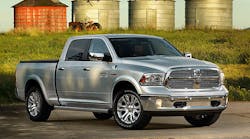There are thousands of moving parts at the Cummins Columbus Midrange Engine Plant (CMEP); not just the parts that go into the complex Dodge Ram Truck engines built at the facility, but the many moving parts – people, machinery, industrial trucks, production lines – that build those engines in a nearly 600,000-square-foot facility. It’s a lot to manage and a lot to manage safely.
“We have many safety challenges,” acknowledged Jed Cowell, the plant manager. “Fluid management – diesel fuel, oil, caustic chemicals, some VOCs; lockout/tagout; confined space, ergonomics… We produce 600 engines a day with a lot of interaction between people and machines and tools. We have forklifts and J-hooks that must get the engines across the plant without interaction with pedestrians.”
From the very start of the tour of CMEP, it was obvious that management and employees are engaged in safety. “The safer anyone is, the safer everyone is,” said Cowell.
The emphasis on safety is not surprising, considering that Cummins Inc. was recognized as one of America’s Safest Companies in 2010. As of 2012, CMEP had produced 2 million truck engines and was named Powertrain Supplier of the Year by Daimler Chrysler.
“What you won’t see here is the perfect plant,” Cowell told tour participants, who were from MSA, Starbucks, Federal Signal, Procter & Gamble and other companies. “We’re on our safety journey.”
Other tours: SLC 2014: There’s Nothing Top-Secret About Raytheon's Safety Best Practices [Photo Gallery] and SLC 2014: Continuous Safety: The Toyota Way.
The safety program at the facility is built on three basic tenets: Prevent, comply and improve. Before any significant changes are made to the production lines or robots are added, a change request is submitted and any business group, department or work team that is impacted must sign off on the project. Pre-risk and post-risk assessments are conducted by the safety department to ensure that employees remain safe and environmental concerns are met.
Changes are taken very seriously at the facility, said Cowell. “Safety issues happen when things are different,” he noted.
Employees are empowered to speak up about safety and, in fact, warned people on our tour who were not wearing steel-toed shoes when they stepped into areas where safety shoes are required. Even tour participants were encouraged to speak up if they saw housekeeping or safety or compliance issues.
“It’s always good to have a new set of eyes, especially trained safety professionals,” said Cowell. “Fresh eyes are great.”
